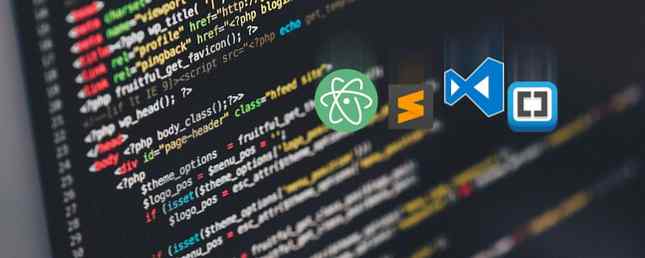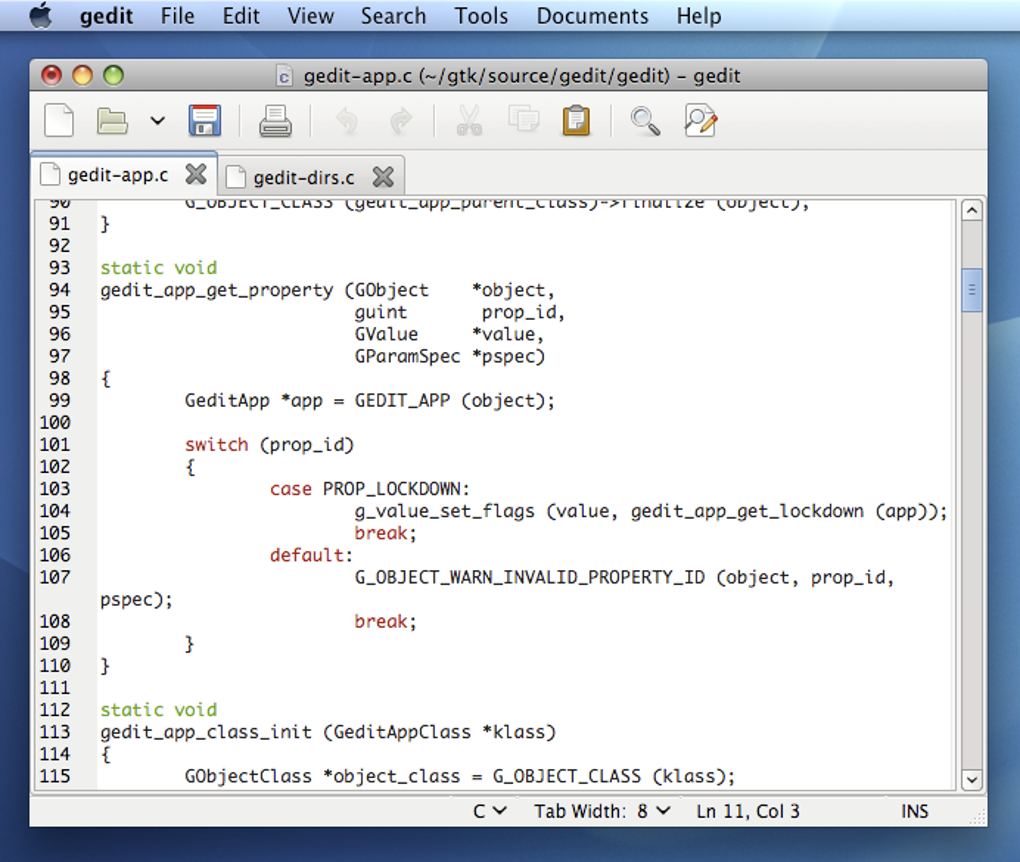My first ever blog post on gnome blogs, and about time. Today I ‘finished’ my earlier porting of gedit to OS X. Although we did the initial port some time ago, it was more a proof-of-concept than actually something usable. That is, I was the only one who could use it. Not any more though! I finally sat down to make it into an actual OS X App Bundle (using the excellent ige-mac-bundler). We include everything that we need in there, so it should be entirely standalone. That also means that the full thing is about 100 MB :(
- Download Gedit Mac Terminal
- Gpedit Download Microsoft
- Gedcom File Viewer Mac
- Best Text Editor For Mac
- Gedit Download Macbook
I was pretty impressed by how well OS X is supported by gtk+ and friends already, but I did hit some snags on the way. One of them was gconf. We decided that it would be simpler for now not to involve dbus, so we went with gconf 2.22. Unfortunately, gconf has hardcoded install paths, and since we want to put everything in a single bundle, this was causing some problems. In the end I patched it to replace the compile time prefix with a prefix set as an environment variable. Other than that I had some issues with python modules installing in the wrong place, and I had to patch ige-mac-integration in some places to get a bit nicer menu integration (especially accelerators). All in all pretty smooth, but still about a days work to get it all done.
So, what do you get? If you’re the proud owner of a Mac (running OS X 10.4 intel), feel free to download the installer for gedit 2.26.2. After downloading, you should be prompted with the following:
Download gedit 2.30.2 for Mac. Fast downloads of the latest free software! Download Gedit for Mac to edit text and code with comfort. This Mac download was scanned by our antivirus and was rated as safe. The most popular versions of the application are 3.2 and 2.3. This free Mac application was originally produced by The GNOME Project. The file size of the latest installation package available for download is 22.3 MB. The unique ID for this program's bundle is org.gnome.gedit. Visual Studio Code. Free. Proprietary. Chrome OS ▼ Extensible by Plugins/Extensions. This is a Mac-only app and is especially well-suited for editing CSS. Whether it’s Python, Perl, Ruby, HTML/CSS, Javascript, etc., Komodo IDE can handle it all. It’s free to use and has all the features you may need to get your project done, complete with debugging and testing.
After launching gedit, you should be prompted with something like this:
So there it is, gedit nicely running on OS X natively. It features:
- Menu integration (including appropriate shortcuts)
- Full support for plugins (both C and Python)
- Everything else you expect from gedit
Here’s how to download Mac OS X El Capitan DMG file also. MacOS X El Capitan is a stable version of OS X and it is quite different and known as the advanced version of Mac. This operating system contains countless supplements and a variety of work capacities. In this launch, Apple primarily concentrated on compatibility, security, and stability.
Of course there are still some things to be done:
- There is no help yet (somehow, building the help eats all of my 4G of mem, crashing python for xmlpo)
- More and more integration (proxy icon, dock menu)
- Translations do not seem to be working at the moment
Update:
There is a new dmgincluding help, translations, better integration (proxy icon, closing/quitting) and most of the plugins in gedit-plugins.
Getting Started with 'Terminal' - MUST READ Before You Start Programming

Programmers use 'Terminal' to issue commands, instead of the graphical user interface - which is meant for common users.
You MUST have some basic knowledge on using the Terminal and the file system. Read 'Unix Survival Guide for Mac & Ubuntu - Terminal, File System and Users'.
How to Install JDK and Get Started with Java Programming on Mac
Read HERE.
Programming Text Editors for Mac
TextEdit for Mac
TextEdit (the default text editor in Mac OS X) is NOT a programming text editor, as it lacks features like syntax highlighting. I strongly suggest you install a programming text editor.
To use TextEdit to write source file, you need to open a new file ⇒ choose 'Format' ⇒ 'Make Plain Text'.
You can open an existing file in TextEdit from Terminal by issuing:
nano (or pico) Command-line Text Editor
nano is a GNU text editor that is available for Unix Systems (including Mac OS X), that is suitable for creating/editing small files. To start nano, open a Terminal and issue:
You can run nano with superuser (for accessing restricted directories), as follows:
JEdit for Mac
jEdit is a popular open-source cross-platform (Mac, Windows, Linux) programming text editor. The mother site is http://www.jedit.org.
Step 1: Download and Install jEdit for Mac
- Download jEdit package from http://www.jedit.org ⇒ Download ⇒ Select Mac OS X package (stable version).
- Double click the downloaded Disk Image ('
.dmg') file. Drag the 'jEdit' icon to 'Applications' folder. - Eject the Disk Image '
jedit.dmg'.
Step 2: Install 'Console' plugins
- Launch jEdit (from 'Applications').
- Open plugin manager: From 'Plugins' menu ⇒ Plugin Manager.
- Select 'Install' tab.
- Search and select 'Console' plugin. 'ErrorList' plugin will selected automatically ⇒ Install.
Step 3: Write a Hello-World Java Program
Download Gedit Mac Terminal
- Open a new file by selecting 'File' menu ⇒ 'New'.
- Enter the following Java source code and save the file as '
Hello.java'.
Step 4: Compile and Run the Hello-World Java Program
You can start a 'Terminal' to compile and run your Java program as described in the above JDK section.
You can also use the 'Console' plugin:
- To compile: From Plugins ⇒ Console ⇒ Compile Current Buffer. Click on the 'Console' button to view the console. If message 'Process javac exited with code 0' appears, the program is compiled successfully.
- To run: From Plugins ⇒ Console ⇒ Run Current Buffer.
gedit for Mac
gedit is the official text editor of the GNOME desktop environment. The mother site for gedit is http://projects.gnome.org/gedit/.
- Download gedit for Mac (DMG version) from http://projects.gnome.org/gedit/ ⇒ 'gedit mac os x' ⇒ Choose your specific Mac OS version.
- To install:
- Double-click the downloaded Disk Image ('
.dmg') file. - Drag the 'gedit' icon to the 'Applications' folder.
- Eject the Disk Image '
gedit.dmg'.
- Double-click the downloaded Disk Image ('
Gpedit Download Microsoft
Notes: To use 'gedit' commands in Terminal, you need to add '/Applications/gedit.app/Contents/MacOS/' to PATH environment variable.
Sublime
@ http://www.sublimetext.com.
How to Install Eclipse on Mac
Read 'How to Install Eclipse for Mac OS'.
How to Install NetBeans on Mac
Read 'How to Install NetBeans on Mac'.
How to Install MySQL 5.6 on Mac OS X 10.7 Lion
Gedit Linux Download
Install MySQL using the DMG Package
Reference: 'Installing MySQL on Mac OS X' @ http://dev.mysql.com/doc/refman/5.6/en/macosx-installation.html.
Step 1: Download and Install MySQL
Download the MySQL 'DMG Archive':
- Go to http://dev.mysql.com/downloads/mysql/. In platform, select the 'Mac OS X'.
- Select the appropriate 'DMG Archive' for your specific Mac OS version:
- Click the Apple logo ⇒ 'About this Mac' to check your Mac OS version.
- Read http://support.apple.com/kb/ht3696 to check if your OS is 32-bit or 64-bit.
- Click 'No thanks, just start my download'.
To install MySQL:
- Go to 'Downloads' ⇒ Double-click '
.dmg' file downloaded. - Double-click '
mysql-5.5.{xx}-osx10.x-xxx.pkg' ⇒ Follow the instructions to install MySQL. Click continue if 'unindentified developer' warning dialog appeared. - MySQL will be installed in '
/usr/local/mysql-5.5.{xx}-osx10.x-x86_xx' directory. A symbolic link '/usr/local/mysql' will be created automatically to the MySQL installed directory. - Eject the '.
dmg' file.
Step 2: Configuring MySQL - Change TCP Port Number for MySQL Server
- The default TCP port number used by MySQL Server is 3306.
- [For novices: SKIP THIS STEP to run the MySQL Server on port 3306. Goto Step 3.]
You can change the port number by editing the configuration file 'my.cnf' at directory '/usr/local/mysql'. To create this file, open a new 'Terminal' and run the 'nano' editor using this command: Modify the lines in green and add in the lines in red; and press ctrl-X to exit. (We use the 'nano' editor in this case, you can use any text editor, but run in superuser.)
Notes: On Unix/Mac, the MySQL read the options file in this order: '/etc/my.cnf', 'SYSCONFDIR/mf.cnf', '$MYSQL_HOME/my.cnf', '~/.my.cnf'.
Step 3: Start/Shutdown the MySQL Server
Open a new 'Terminal' and issue these commands to start the MySQL server:

To shutdown the server, start a new terminal and issue:
Step 4: Start/Stop a MySQL Client
Open a new 'Terminal' and issue this command to start a MySQL client with superuser root:
To terminate the client, issue command 'exit' (or 'quit') from the 'mysql>' prompt:

Notes:

- You can use 'Activity Monitor' (under Applications/Utilities) to check if the MySQL Server is running. Look for process starting with
mysqld. - The log messages are written to
/usr/local/mysql/data/xxx.err, wherexxxdenotes your machine name. Issue 'sudo cat /usr/local/mysql/data/xxx.err' to view the messages. - If you get the following error message when starting a client: 'Can't connect to local MySQL server through socket '..', check your 'Activity Monitor' to see if the MySQL server has been started.
Step 5: (For Java Programmers) Install MySQL JDBC Driver
- Download the latest JDBC driver from http://www.mysql.com/downloads ⇒ MySQL Connectors ⇒ Connector/J ⇒ Compressed TAR archive (e.g.,
mysql-connector-java-{5.x.xx}.tar.gz, where{5.x.xx}is the latest release number). - Double-click on the downloaded TAR file to expand into folder '
mysql-connector-java-{5.x.xx}'. - Open the expanded folder. Copy the JAR file '
mysql-connector-java-{5.x.xx}-bin.jar' to JDK's extension directory at '/Library/Java/Extension'.
How to Uninstall and Remove MySQL 5
- Open a Terminal ⇒ Run the '
nano' editor to edit/etc/hostconfig, as follows: Delete this line if present: 'MYSQLCOM=-YES-'. Press cntl-x to exit 'nano' and enter 'Y' to save the file. The line 'MYSQLCOM=-YES-' starts MySQL automatically during startup. - Make sure that MySQL is not running (Open the 'Activity Monitor' under the 'Applications/Utilities', and check for the process '
mysqld'). Open a Terminal and issue 'rm -r' to remove these directories and their sub-directories (with 'f' indicating no confirmation prompt).
That's all!
(Advanced) Install MySQL using Tarball
Reference: http://dev.mysql.com/doc/refman/5.5/en/macosx-installation-pkg.html.
Gedcom File Viewer Mac
[TODO]
How to Install Tomcat 7 on Mac
Step 1: Download and Install Tomcat
- Goto http://tomcat.apache.org ⇒ Download ⇒ Tomcat 7.0 ⇒
7.0.{xx}(where{xx}denotes the latest release) ⇒ Binary distribution ⇒ Core. Download the 'tar.gz' package (e.g., 'apache-tomcat-7.0.{xx}.tar.gz'). - To install Tomcat:
- Goto '
~/Downloads', double-click the downloaded TAR file (e.g., 'apache-tomcat-7.0.{xx}.tar.gz') to expand it into a folder (e.g., 'apache-tomcat-7.0.{xx}').(Notes for Advanced Users) Alternatively, you can use thetarcommand to expand the tarball as follow: - Move the extracted folder (e.g., '
apache-tomcat-7.0.{xx}') to '/Applications'. - Rename the folder 'tomcat', for ease of use.
- Goto '
(Notes for Advanced Users):
- It is probably better to keep the tomcat in '
/usr/local' or '/Library'. - Instead of renaming the tomcat's folder, it it better to create a symlink called tomcat as follows:
- For security reason, you should not run Tomcat as root user. Instead, assign Tomat to user nobody (of group nobody):
Step 2: Configure Tomcat Server
Read 'Configure Tomcat Server'.
Step 3: Start the Tomcat Server
To start the Tomcat server, open a new 'Terminal' (Go ⇒ Utilities ⇒ Terminal) and issue:
Check for the Tomcat server's TCP port number from the console messages. The default is 8080.
To verify if the Tomcat server is started, start a browser (Safari) and issue URL http://localhost:8080, suppose that Tomcat is running on the default TCP port number of 8080.
Install Gedit
Also try URL http://localhost:8080/examples which shows the Servlet/JSP examples.
Step 4: Shutdown the Tomcat Server
To shutdown the Tomcat server, you can simply press control-c (NOT command-c) on the tomcat console, or issue command:
Step 5: Servlet API
Install Gedit Mac
To write Java servlets, you need to COPY the Servlet API JAR file ('servlet-api.jar') from '/Applications/tomcat/lib' to the JDK's extension directory at '/Library/Java/Extension'.
Installing GCC and Get Started with C/C++ Programming on Mac
Download Gedit Mac Os X 10.10
To install
- Goto http://connect.apple.com, and login with your AppleID.
- Download 'Command Line Tools (OS X xxxx) for XCode' Disk Image (DMG).
- Double-click the download disk image (DMG) ⇒ Open '
Command Line Tools (xxx).mkpg' ⇒ Follow the instructions to install. - Eject the disk image.
Gedit Editor
To verify:
Installing XCode & Get Started
XCode is the development toolset for Mac, iPhone/iPad, which includes the Mac OS SDK (for Mac) and iOS SDK (for iPhone/iPad).
To install:
- Goto http://connect.apple.com, and login with your AppleID.
- Download 'XCode 4.x' Disk Image (DMG) - It is HUGE!
- Double-click the download disk image (DMG) ⇒ Open 'XCode' ⇒ Follow the instructions to install.
- XCode will be installed in '
/Developer/Applications/Xcode'. - Eject the disk image.
Download Gedit Mac Os X 10.13
To start Xcode, launch 'XCode' from '/Developer/Applications'.
[TODO] Getting Started

More on Terminal & Bash Shell
Goto 'Terminal & Bash Shell'.
Mac's Tips & Tweaks
Root (or Superuser, or Administrator)
In some cases (such as installing software and starting server), you need to be the so-called root user (or superuser or administrator) of your machine to complete some commands that require high privilege. Put 'sudo' (superuser do) in front of your command to run the command as root user, and provide the your password. Only authorized user can issue sudo command. For example, to start the MySQL server:
How to View All Files in Finder
- Open a terminal and enter this commands:
- Stop the Finder via:
- Re-start the Finder. You shall see all the files (including the dot files and dot folders) now.
Miscellanous
Best Text Editor For Mac
- The equivalent of Windows' 'Task Manager' in Mac is called 'Activity Monitor' under 'Applications/Utilities'.
- The page-up, page-down, home and end keys are fn-up-arrow (or command-up-arrow), fn-down-arrow (or command-down-arrow), fn-left-arrow and fn-right-arrow, respectively.
Gedit Download Macbook
Contributed by Wang Qiang ([email protected]).